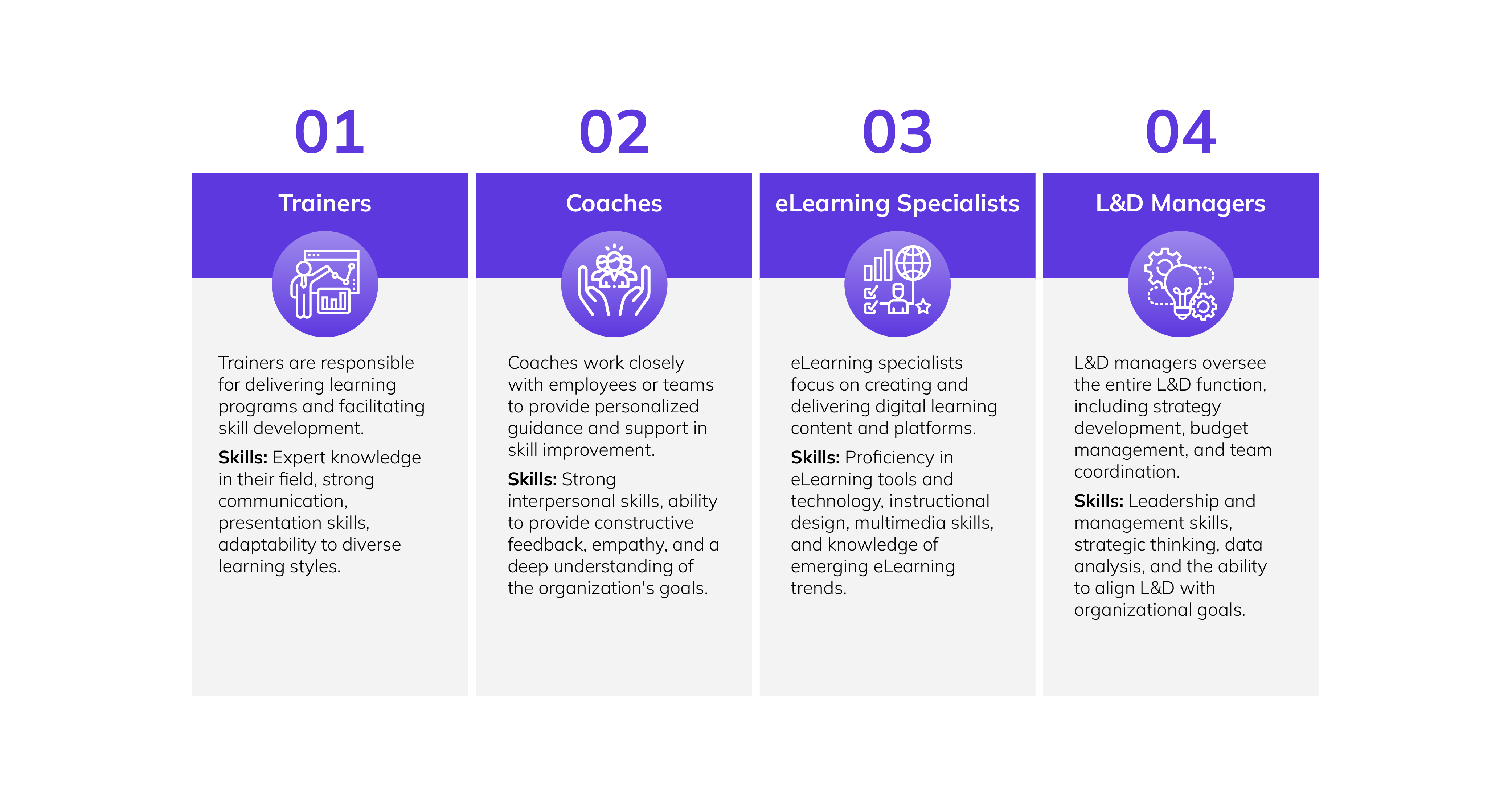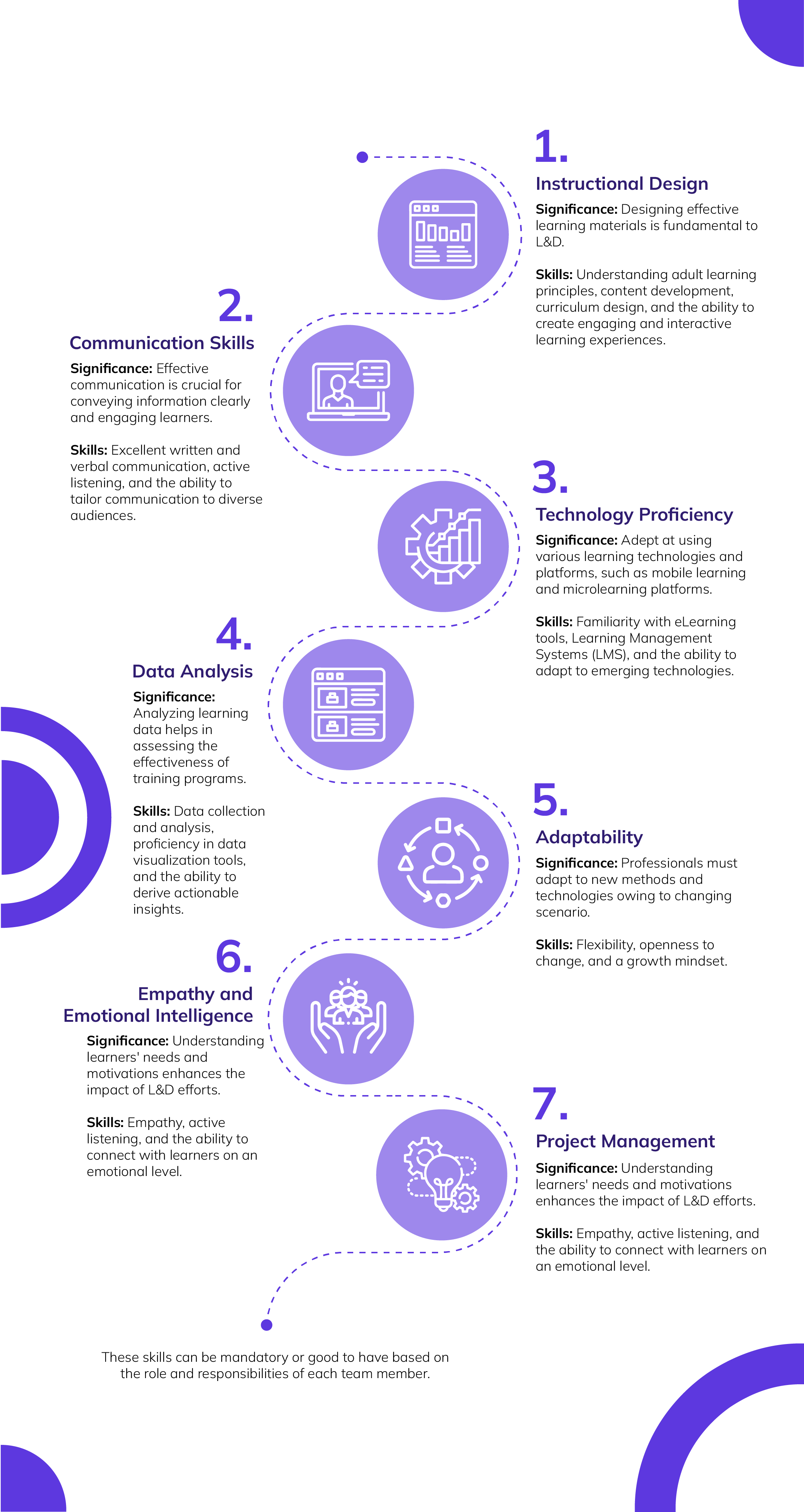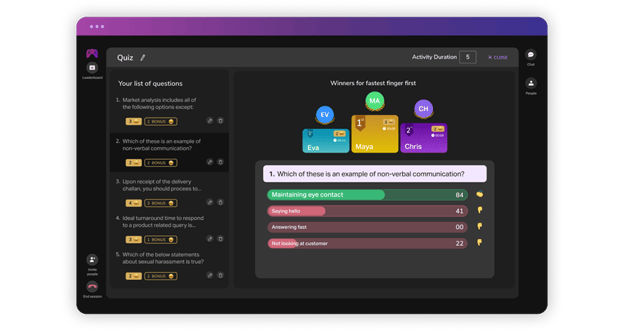In the last decade, workplaces changed a lot because of intense competition, the digital revolution, and complex industries. These factors have altered how employees think and work. Additionally, uncertainties, a diverse workforce, and shorter knowledge lifespans highlight the immediate importance of employee upskilling and reskilling efforts.
These trends have enhanced the significance of the learning and development (L&D) function. To maximize the benefits of training and curriculum development, L&D leaders must assume a larger role within the organization. They should also establish a clear and compelling vision for their work.
A crucial aspect of this endeavor involves creating a comprehensive, well-coordinated L&D strategy that fosters engagement and collaboration throughout the organization.
Let’s delve into the comprehensive topic of L&D, and understand the challenges faced by L&D teams. Additionally, we will discuss methods to enhance L&D efforts to achieve better ROI.
What is Employee Learning and Development?
Learning and development is a process to improve employee skills, knowledge, and competence, leading to better performance at work. Learning is gaining new knowledge, skill sets, and attitudes, while development is improving expertise for personal growth goals.
Importance of L&D for Employees and Employers
As organizations navigate the challenges posed by the Great Resignation, the significance of L&D takes center stage. Over 80% of companies recognize the significance of L&D in fostering a people-focused culture and driving business growth.
This highlights the importance of L&D trends for both employees and employers. This shows that L&D is important for both employees and employers.
Employees benefit a lot by continuously acquiring and adapting skills, empowering them for career growth and boosting self-confidence. In an uncertain job market with frequent changes, L&D initiatives enhance job satisfaction and reduce the urge to look for other opportunities.
Meanwhile, for organizations, robust L&D programs emerge as a powerful retention strategy, showcasing a genuine dedication to employee growth and development. This commitment, in turn, helps companies retain their invaluable talent pool even amidst a period of heightened workforce mobility.
To grow and stay stable, it's important to understand the connection between Learning and Development (L&D) and organizational success. This underscores the importance of investing in employee development.
What is the role of L&D in Organizations?
L&D provides employees with vital knowledge and skills for their roles. This, in turn, drives talent development, enabling effective succession planning, and fostering a culture of continuous learning. Its diverse role spans across key areas within organizations. Let's delve into them.
Employee Training and Skill Enhancement
L&D initiatives target employee skill gaps and learning needs. Specialized training helps them acquire new skills, refine existing ones, and stay updated on industry trends. This creates a more proficient workforce ready for career progression, benefiting both employees and the L&D team in the organization.
Talent Development and Succession Planning
L&D plays a crucial role in talent development and succession planning by identifying and nurturing high-potential employees. L&D fosters future leaders through mentorship, leadership programs, and personalized development plans within the organization.
This proactive talent development approach reduces risk with leadership gaps and ensures smooth transitions when key positions need filling.
Organizational Learning
L&D establishes the framework for organizational learning. This includes creating learning management systems, providing access to online courses and resources, and designing virtual training spaces. L&D also encourages the sharing of insights and expertise among employees.
Through workshops, collaborative projects, and knowledge-sharing platforms, employees can exchange ideas, best practices, and lessons learned. This cross-functional knowledge transfer enhances problem-solving capabilities and promotes innovation within the organization.
Key Areas that Learning and Development Strategies Can Improve
Attracting and Retaining Top Talent:
A joint study by Amazon and Workplace Intelligence shows that 89% of employees want to improve their skills. Gen Z and Millennials prefer companies offering training, and LinkedIn’s Report found companies excelling at upskilling retain employees for an average of 5.4 years, nearly double the retention span of other companies.
Employee Engagement
Employee satisfaction increases with opportunities to advance their knowledge, making them more engaged. Employees generally perceive learning and development opportunities as enhancing their engagement at work.
Employer Branding with L&D
An employer brand reflects a company's image to candidates and employees. Demonstrating investment in employee development through L&D can boost this image, as LinkedIn’s Global Talent Trends report shows candidates prioritize upskilling when looking for jobs.
Workplace Culture
MIT Sloan's study reveals that nearly 30% of employees consider corporate culture a key reason for staying with their employers, with learning and development as essential to their desired workplace culture. Employees value organizations that promote continuous learning amidst tech advancements.
What Makes a Good L&D Team?
A well-structured L&D team is crucial for an organization's growth and success. Such teams encompass a range of essential roles, each contributing unique skills and expertise. Moreover, the professionals in these roles need to possess certain key skills to effectively facilitate L&D within the organization.
Here's an exploration of what makes a good L&D team, including the crucial roles and skills:
Key L&D Roles

Trainers are responsible for delivering instructional content and facilitating learning sessions. They use their expertise to teach specific skills and knowledge, often through workshops, seminars, and hands-on activities.
Coaches provide personalized guidance and support to employees, helping them develop specific skills and overcome challenges. They focus on individual growth and performance improvement through one-on-one sessions and feedback.
Elearning specialists design, develop, and implement digital learning solutions. They create engaging online courses and learning modules, leveraging technology to enhance the accessibility and effectiveness of training programs.
L&D Managers oversee the entire learning and development strategy within an organization. They plan, coordinate, and evaluate L&D initiatives, ensuring they align with business goals and address employees' skills gaps.
6 Key Skills Important for L&D Professionals:
1) Instructional Design
2) Communication Skills
3) Technology Proficiency
4) Data Analysis
5) Adaptability, and
6) Empathy and Emotional Intelligence

Challenges Encountered by Organizations in the L&D Space
Technological Advancements
The rapid evolution of technology demands continuous adaptation from L&D teams. It is important to keep up with new tools and platforms. However, using them effectively and ensuring accessibility for everyone can be challenging.
Employee’s Resistance to Change
Employee resistance to change can hinder the successful implementation of new learning methods. Employees may be hesitant to embrace novel training approaches or technologies, creating a barrier to L&D initiatives' effectiveness.
ROI
Quantifying the ROI for L&D programs remains a challenge. Proving that training leads to real business results is often difficult. This difficulty makes it challenging to justify the budget for learning and development.
Measuring Effectiveness
Accurately assessing the impact and effectiveness of L&D initiatives requires the development of robust evaluation methods. These methods must capture improvements in employee skill set and performance, which can be a complex process.
Diverse Workforce Demands
Modern work environments are marked by a variety of generations, cultures, and learning approaches. L&D professionals face a complex challenge in meeting the diverse learning needs and preferences of the workforce. This challenge requires a careful approach to training and development.
5 Effective L&D Strategy Examples that can Inspire
1) Yelp promotes learning and development through stretch roles and internal promotions, with 98% of its sales management roles filled by internal candidates.
2) Money Supermarket launched an online platform during the pandemic that customizes specific learning experiences to each role, including skill rating and personalized content feeds.
3) Google offers a flexible learning environment through its Google-to-Google program, an internal network for peer-to-peer employee training.
4) NSPCC, a UK charity, focuses on its innovation program "=-mc" to increase donations, creating 50 innovation champions and providing ongoing coaching and support.
5) Cruise Automation launched a mentorship program in 2019, pairing young and experienced employees and providing resources to enhance these mentoring relationships.
L&D Strategies for Successful Outcomes
Identifying Learning Needs
Effective L&D begins with a clear understanding of employee skills gaps. Conduct a thorough need-based assessment, which may include surveys, performance reviews, and input from employees and managers. Improving sales negotiation skills in the sales team through targeted training to address skill gaps. Use an AI platform to assess learning needs and skills, making the process easier.
Petronas achieved an 88% agility score with Disprz LXP. They swiftly identified what their employees needed to learn and identified those who were quick to learn.
Designing Effective L&D Programs
Well-structured L&D programs aligned with clear learning objectives are fundamental to success. When designing these programs, consider factors such as the target audience, desired outcomes, and available resources.
When creating a cyber security awareness program, make modules about recognizing phishing and staying safe online. Make sure they help improve security awareness.
Advanced platforms like Disprz AI-powered platform can help with the designing of effective L&D programs. The platform lets you customize courses as per requirements and measure the impact of the outcomes.
Read how Paragon Corp transformed their employee learning with targeted L&D programs, using Disprz LXP.
Choosing L&D Delivery Methods
Selecting the right delivery method is critical to ensure effective training. It involves considering factors such as the nature of the content, the preferences of the learners, and logistical considerations.
For geographically spread-out teams, opt for virtual instructor-led training. This ensures a consistent learning experience for everyone, no matter where they are located.
Platforms like Disprz LXP can facilitate live training, classroom training and self-paced learning as per your organization's requirements.
Ensuring Employee Engagement and Motivation
Engaging and motivating content is paramount to successful learning. To achieve this, leverage techniques such as gamification, interactive elements, and real-world scenarios. For example, integrating gamification into training programs can allow employees to earn rewards or badges as they complete modules or achieve specific milestones. This will help boost engagement and motivation.
To gamify L&D, you must incorporate a learning experience platform (LXP) with advanced gamification features. The LXP you choose should have the following elements:
-
Quizzes and polls
-
Breakout rooms for team collaboration or competitions
-
Leaderboards
-
Badges to highlight accomplishments
 Figure: Gamification features in LXP
Figure: Gamification features in LXP
Measuring Learning Outcomes
Measuring progress and outcomes is vital to assess the effectiveness of L&D efforts. Establish clear, measurable learning objectives before training begins. After the training, assess employee knowledge and skills using quizzes, assessments, or real-world performance evaluations.
For instance, to measure the success of a customer service training program, track customer feedback. Compare the feedback to pre-training data. This will help determine if customer satisfaction has improved.
Use an AI-based LXP to assess learning outcomes and ROI in learning and development. This will provide a complete view of important learning measurements. The platform helps you track data, find trends, and gain insights into areas needing improvement in your training program.
Ready to Implement a Winning L&D Strategy?
Aligning learning and development with business strategy is essential for maintaining a competitive edge in today's rapidly evolving market. By involving business leaders in the design process, identifying employee skills gaps, and creating a continuous learning platform, organizations can ensure their workforce remains agile and capable.
Effective implementation of L&D initiatives, supported by thorough planning and budget considerations, along with tracking performance through key metrics, guarantees that training programs are impactful and relevant. Regularly analyzing the effectiveness of these programs and incorporating employee feedback ensures continuous improvement and alignment with business goals. Investing in L&D not only enhances employee skills but also strengthens overall company performance, fostering a culture of continuous growth and adaptation.









